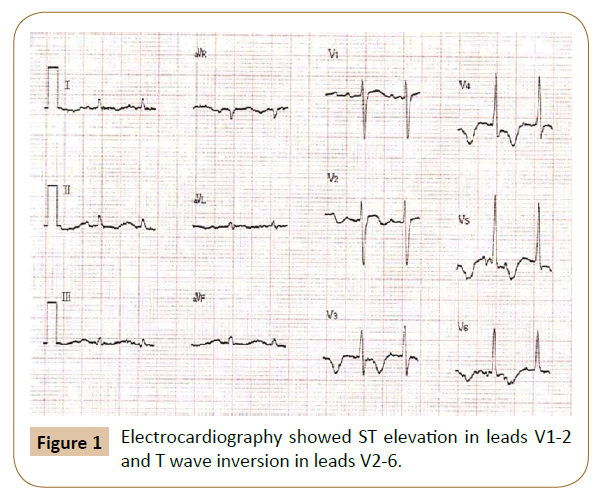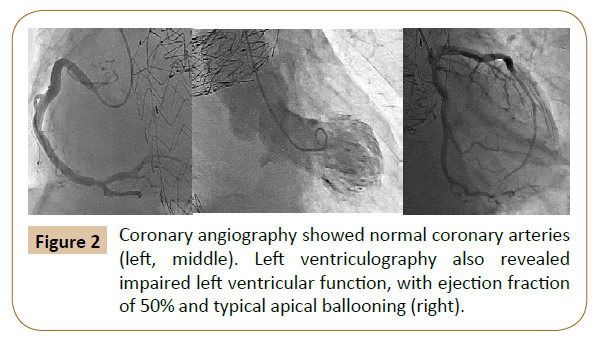Takotsubo Cardiomyopathy after Hybrid Repair of Thoracic and Thoracoabdominal Aortic Aneurysm
Tetsuro Uchida, Azumi Hamasaki, Yoshinori Kuroda, Atsushi Yamashita, Jun Hayashi and Mitsuaki Sadahiro
DOI10.21767/2573-4482.100043
Tetsuro Uchida*, Azumi Hamasaki, Yoshinori Kuroda, Atsushi Yamashita, Jun Hayashi and Mitsuaki Sadahiro
Second Department of Surgery, Yamagata University, Yamagata, Japan
- *Corresponding Author:
- Tetsuro Uchida
Second Department of Surgery
Yamagata University, 2-2-2 Iida-Nishi
Yamagata 990- 9585, Japan
Tel: +81-23-628-5342
Fax: +81-23-628-5345
E-mail: t-uchida@med.id.yamagata-u.ac.jp
Received Date: March 16, 2017; Accepted Date: March 28, 2017; Published Date: April 04, 2017
Citation: Uchida T, Hamasaki A, Kuroda Y, et al. Takotsubo Cardiomyopathy after Hybrid Repair of Thoracic and Thoracoabdominal Aortic Aneurysm. J Vasc Endovasc Surg. 2017, 2:11. doi: 10.21767/2573-4482.100043
Abstract
Context: Takotsubo cardiomyopathy is characterized by transient and acute left ventricular dysfunction with apical dyskinesia in the absence of coronary artery disease. The pathophysiology of this rare disease is considered to be associated with physical and psychological stress. Recently published case reports have described the association between Takotsubo syndrome and various surgical procedures as the causative stress factors. However, Takotsubo cardiomyopathy is extremely rare in patients who have undergone cardiovascular surgery.
Case report: Here, we report a rare case of Takotsubo cardiomyopathy developing after thoracic endovascular aortic repair for chronic dissecting aortic aneurysm.
Conclusion: This patient developed Takotsubo cardiomyopathy 14 days after thoracic endovascular aortic repair, potentially because of the prolonged perioperative physical and psychological stress induced by multi-stage surgery. To our knowledge, this is the first report of Takotsubo cardiomyopathy after thoracic endovascular aortic repair. Through this report, we emphasize the importance of considering the possibility of Takotsubo cardiomyopathy in patients presenting symptoms of cardiogenic shock and unexplained hemodynamic deterioration, despite having undergone relatively less-invasive cardiovascular surgery. Early diagnosis is required to initiate appropriate treatment and to minimize the chance of complications.
Keywords
Cardiovascular; Takotsubo cardiomyopathy; Thoracic; Aortic aneurysm; Endovascular; Thoracic surgery
Abbreviations
TAVR: Transcatheter Aortic VALVE replacement; TAAA: Thoracoabdominal Aortic Aneurysm; TEVAR: Thoracic Endovascular Aortic Repair
Introduction
Takotsubo syndrome is a rare form of cardiomyopathy, characterized by transient left ventricular dysfunction with apical ballooning in the absence of coronary artery disease. This syndrome was first described in the Japanese population and its pathophysiology was considered to be associated with physical and psychological stress [1]. Recently, case reports describing the relationship between Takotsubo cardiomyopathy and various surgical procedures have been published [2-4]. We report a rare case of Takotsubo cardiomyopathy developing after Thoracic Endovascular Aortic Repair (TEVAR) for chronic dissecting aortic aneurysm. We have not come across any similar case report in the hitherto published literature.
Case Report
A 66-year-old man with a history of Stanford type B aortic dissection was referred to our institution for the treatment of thoracic and type II Thoracoabdominal Aortic Aneurysm (TAAA). Previously, he had been treated medically for severe chronic obstructive lung disease. The computed tomography images revealed a dissecting aneurysm, extending from the aortic arch to abdominal aorta, with a maximum diameter of 85 mm. Since he was a high-risk patient, traditional TAAA repair necessitating thoraco-laparotomy was considered unsafe. Hence, a multi-stage hybrid surgery was planned. In the first stage, an abdominal aortic aneurysm was replaced with a bifurcated Dacron Y-graft through a midline laparotomy. The four visceral branches of aorta were revascularized with the pre-sewn branches of the Y-graft. One month after the initial surgery, total aortic arch replacement using the elephant trunk technique, was performed through median sternotomy. This was followed by TEVAR (Relay Plus®, Bolton medical, Barcelona) 7 days later. The stent graft was deployed from the elephant trunk to the straight portion of the Y-graft, without anastomosis to the side branches. The final angiographic images confirmed no endoleaks or patient visceral vessels. On the day following TEVAR, he was extubated in good general condition. The postoperative course was uneventful until day 14, when the patient developed sudden-onset chest pain. Electrocardiography indicated a new-onset of ST elevation, in leads V1-2 and T wave inversion in leads V2-6 (Figure 1). The maximal troponin T level was 0.2 ng/mL, and creatinine phosphokinase-MB was 3.2 ng/mL. Echocardiography revealed significantly reduced left ventricular function with extensive akinesis and dyskinesis of all apical and midventricular segments. The left ventricular ejection fraction was estimated to be lower than 50%. His condition gradually deteriorated and he turned hypotensive and oliguric. Although there was no elevation of cardiac enzymes and a previous coronary angiogram was normal, acute myocardial infarction was suspected as the cause of left ventricular dysfunction. Emergency coronary angiography was performed soon after the onset, but showed normal coronary vessels with impaired left ventricular function, an ejection fraction of 50%, and apical ballooning (Figure 2). Based on the typical findings of impaired left ventricular function and apical ballooning with normal coronary arteries, a diagnosis of Takotsubo cardiomyopathy was confirmed. The cardiogenic shock was gradually stabilized with low-dose inotropic support. Repeat echocardiogram after three days showed left ventricular ejection fraction improvement. The postoperative course of the patient was uneventful.
Discussion
Takotsubo cardiomyopathy was first reported by Dote and associates in the Japanese population [1]. The condition was characterized by transient and acute left ventricular dysfunction, with apical dyskinesia in the absence of coronary artery disease [5]. This syndrome mainly affects postmenopausal women following stressful acute emotional or physiologically events [6]. The exact pathophysiological mechanisms of this syndrome remain unclear, although some hypotheses have been proposed, including multi-vessel epicardial coronary spasm, microvascular coronary spasm, and excessive catecholamine-mediated toxicity [7,8]. Complications of Takotsubo cardiomyopathy include left ventricular dysfunction, cardiogenic shock, dynamic intraventricular obstruction, mitral regurgitation, ventricular arrhythmia, left ventricular mural thrombus formation, and left ventricular free wall rupture [9]. However, this transient but serious disorder can usually be managed successfully by conservative therapy, and the overall prognosis seems to be favorable [10].
Four criteria have been proposed for the diagnosis of Takotsubo cardiomyopathy: (1) New electrocardiographic abnormalities, either via ST elevation or T wave inversion; (2) Absence of obstructive coronary artery disease; (3) Transient akinesia or dyskinesia of the left ventricle; and (4) The absence of (idiopathic) cardiomyopathy, head trauma, intracranial bleeding, or pheochromocytoma [9]. All four criteria were positive in our patient. Hence, an early diagnosis was made and appropriate treatment was initiated, resulting in an uneventful clinical course.
With increasing clinical awareness of Takotsubo cardiomyopathy, several cases of this syndrome associated with various types of surgery or anesthesia have been reported [2-4,10]. General anesthesia and the surgical procedure itself were considered to be triggers for the onset of this syndrome. It was suggested that not only physical, but also psychological stress also played an important role in these settings.
Takotsubo cardiomyopathy after cardiovascular surgery is rare, but some cases have been previously reported in the literature [2-4]. Physical and emotional stress can be observed persistently during the perioperative period in cardiovascular surgery, and it could be a possible trigger for onset of the syndrome [2]. However, in patients undergoing cardiac surgery, requiring Cardiopulmonary Bypass (CPB) and aortic cross-clamp, and other differential diagnoses, could lead to low postoperative cardiac output. Poor myocardial protection and coronary air embolism should be considered [3]. Cardiac surgeons should be aware that postoperative Takotsubo cardiomyopathy can mimic low output syndrome after cardiac surgery, and might be clinically masked.
TEVAR is considered to be less invasive compared to conventional open aortic surgery necessitating CPB and thoracotomy, or thoraco-laparotomy, but may entail physical and emotional stress for high-risk patients. Considering the high-risk and complex aortic pathology, this is a unique case of stress-related cardiomyopathy. Harhash et al. reported a case of Takotsubo cardiomyopathy following Transcatheter Aortic Valve Replacement (TAVR), which is a less invasive alternative to conventional aortic valve replacement, especially in high-risk patients [4]. Some stressful events could be a trigger for the syndrome, even in patients undergoing less invasive cardiovascular procedures, such as TEVAR and TAVR. In our patient, Takotsubo syndrome developed 14 days after TEVAR, which was the final stage of the hybrid procedure. Prolonged perioperative physical and psychological stress associated with a multi-stage surgery was considered to be a trigger for the onset of the syndrome. To our knowledge, this is the first report of Takotsubo cardiomyopathy after TEVAR. It is important to consider the possibility of Takotsubo cardiomyopathy in patients presenting with cardiogenic shock, even after less invasive cardiovascular surgery.
In cases of unexplained hemodynamic deterioration after TEVAR, the possibility of Takotsubo cardiomyopathy should be considered. Our experience might impress the importance of an appropriate diagnosis for postoperative left ventricular dysfunction upon surgeons.
References
- Dote K, Sato H, Tateishi H, Uchida T, Ishihara M (1991) Myocardial stunning due to simultaneous multivessel coronary spasms: a review of 5 cases. J Cardiol 21: 203-214.
- Gariboldi V, Jop B, Grisoli D, Jaussaud N, Kerbaul F, et al. (2011) Takotsubo syndrome after mitral valve replacement for acute endocarditis. Ann Thor Surg 91: e31-e32.
- Pergolini A, Zampi G, Casali G, Madeo A, Visconti CL, et al. (2015) Takotsubo syndrome after mitral valve replacement: case report and brief review of the literature. J CardiothoracVascAnesth 29: 431-435.
- Harhash A, Koulogiannis KP, Marcoff L, Kipperman R (2016) Takotsubo cardiomyopathy after transcatheter aortic valve replacement. JACC CardiovascInterv 9: 1302-1304.
- Akashi YJ, Goldstein DS, Barbero G, Ueyama T (2008) Takotsubo cardiomyopathy: a new form of acute, reversible heart failure. Circulation 118: 2754-2762.
- Banihashemi MR, Khan IA (2009) Acute stress-induced cardiomyopathy: a brief observation. Int J Cardiol 134: 273-277.
- Wittstein IS, Thiemann DR, Lima JAC, Baughman KL, Schulman SP, et al. (2005) Neurohumoral features of myocardial stunning due to sudden emotional stress. N Engl J Med 352: 539-548.
- Tsuchihashi K, Ueshima K, Uchida T, Oh-mura N, Kimura K, et al. (2001) Transient left ventricular apical ballooning without coronary artery stenosis: a novel heart syndrome mimicking acute myocardial infarction. Angina Pectoris-Myocardial Infarction Investigation in Japan. J Am CollCardiol 38: 11-18.
- Bybee KA, Kara T, Prasad A, Lerman A, Barsness GW, et al. (2004) Transient left ventricular apical ballooning: a syndrome that mimics ST-segment elevation myocardial infarction. Ann Intern Med 141: 858-865.
- Lee HR, Hurst RT, Vargas HE (2007) Transient left ventricular apical ballooning syndrome (Takotsubo cardiomyopathy) following orthotopic liver transplantation. Liver Transplant 13: 1343-1345.
Open Access Journals
- Aquaculture & Veterinary Science
- Chemistry & Chemical Sciences
- Clinical Sciences
- Engineering
- General Science
- Genetics & Molecular Biology
- Health Care & Nursing
- Immunology & Microbiology
- Materials Science
- Mathematics & Physics
- Medical Sciences
- Neurology & Psychiatry
- Oncology & Cancer Science
- Pharmaceutical Sciences


